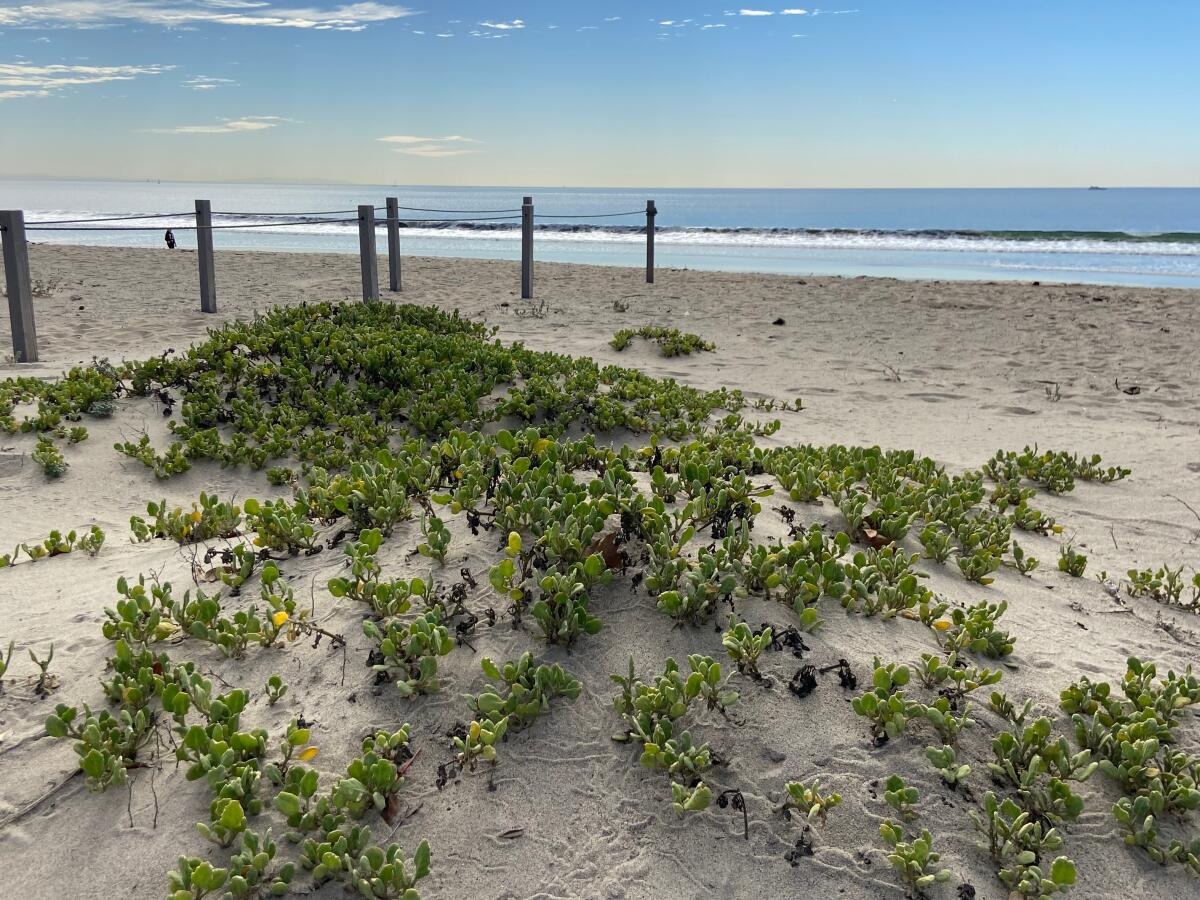Opinion: Here’s one way to protect California’s beaches from rising seas: Stop messing with them

- Share via
Protecting our coasts from sea level rise is increasingly urgent, especially for densely populated coastal communities such as Southern California’s. Coastal flooding and beach erosion from rising seas and storms are far more than a threat; they’re already happening in many places in California and beyond. But new research suggests one relatively simple means of shoring up our beaches: leaving them alone.
As I and my colleagues at UC Santa Barbara and our partner institutions showed in a recent paper, natural dune formation can help restore and adapt urban coasts to climate change. In fact, we found that natural processes can cause the sands to rise much faster than the seas.
Halting the climate catastrophe means halting fossil fuel production. Here’s what the Biden administration can do now .
Our research began in 2016 with a partnership among the Los Angeles-based nonprofit the Bay Foundation, the city of Santa Monica and scientists from UC Santa Barbara to test the capacity of dune restoration to reduce coastal flooding. We envisioned allowing an urban shoreline to return to a more natural state after decades of frequent beach grooming.
Beach grooming, which employs heavy equipment to rake sand, is a widespread practice used to collect trash, remove seaweed and flatten beaches to maintain views and accommodate recreation along urban shores. By altering natural processes such as plant growth and wind- and wave-driven accumulation of sand, grooming prevents dunes from forming on beaches with enough space to develop them.
Without dunes, beaches are less resistant to erosion and more vulnerable to flooding driven by more intense storms and higher seas. Grooming also reduces habitat for wildlife, including threatened species such as the western snowy plover.
After the crucial first step of extensive outreach for community input and securing approval for the demonstration project, we worked with the city, community groups, students and the public to fence off an approximately 3-acre section of Santa Monica Beach next to the Annenberg Community Beach House. The study site was protected from grooming and seeded with native dune plants.
Yes, reducing our use of fossil fuels is essential. But the reality of rapid global warming also demands national strategies to adapt to its effects.
The sand fencing was left open along the ocean side so that people and wildlife could interact with the site and sand could drift in and out with the tides and wind. Interpretive signs and a central public access path enhanced viewing and provided information about the experiment in urban beach restoration. And other than some occasional hand weeding in the initial years, the site progressed naturally on its own without irrigation or any use of heavy equipment.
The native coastal foredune plant species we seeded the site with, such as red sand verbena (Abronia maritima) and beach bur (Ambrosia chamissonis), are specialists at trapping and holding sand in place. As these plants grow, they act as living ecosystem engineers that trap small mounds of sand, grow on top of them, trap more sand and so forth. Over time, with sufficient sand and beach width, they promote the formation of dunes.
Once the demonstration project was in place, we studied its effects over six years. What we found exceeded our expectations.
Wind-driven sand began to accumulate naturally along the sand fences almost immediately. Native plants germinated quickly and spread gradually over time. And as the plants grew and spread, we saw additional sand accumulation and the formation of a small foredune ridge along the ocean edge of the project.
By the sixth year of the study, the new dunes had risen to a height of more than 3 feet in many places. Overall, the site had accumulated more than 2,200 cubic yards of sand — enough to fill more than 200 large dump trucks. The dunes grew at more than 10 times the rate of sea level rise during the years of our study.
Our project, the first of its kind in the region, highlights a nature-based adaptation that can enhance the resilience of beaches and coastal communities while conserving sandy ecosystems. Conducted without heavy machinery or other expensive equipment, it was also cost-effective compared with traditional methods of coastal defense, such as sea walls and coastal armoring. And it can be widely replicated by restricting grooming in areas with enough beach space and sand supply to promote dune formation.
Many more small dune restoration projects are already being implemented throughout California. It’s time to begin scaling up these efforts across our coastlines. We can achieve a healthy balance between continuing to enjoy our beaches for recreation and shifting practices to promote more coastal resilience with thoughtful planning and engagement with all the affected interests. People, plants, plovers and protection can coexist on our beautiful California beaches.
Karina Johnston is a doctoral student at UC Santa Barbara’s Bren School of Environmental Science and Management and the Marine Science Institute.
More to Read
A cure for the common opinion
Get thought-provoking perspectives with our weekly newsletter.
You may occasionally receive promotional content from the Los Angeles Times.












